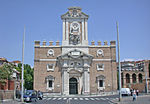Porta Collina

The Colline Gate (Latin Porta Collina) was a landmark in ancient Rome, supposed to have been built by Servius Tullius, semi-legendary king of Rome 578–535 BC. The gate stood at the north end of the Servian Wall, and past it were two important streets, the Via Salaria and Via Nomentana. Within this area the Alta Semita linked the Quirinal with the Porta Carmentalis. Several temples were located near the gate, including temples of Venus Erycina and Fortuna. To a person facing the gate in the 3rd century AD, the Gardens of Sallust would have been on the left, with the Baths of Diocletian on the right.Plutarch says that, when a Vestal was punished for violating her vow of chastity, the subterranean chamber for her live burial was near the Colline Gate. The gate was the site of a decisive battle during the Roman civil wars of the 80s BC between the forces of Cinna and Sulla.
Excerpt from the Wikipedia article Porta Collina (License: CC BY-SA 3.0, Authors, Images).Porta Collina
Via del Macao, Rome Municipio Roma I
Geographical coordinates (GPS) Address Nearby Places Show on map
Geographical coordinates (GPS)
| Latitude | Longitude |
|---|---|
| N 41.907338888889 ° | E 12.498713888889 ° |
Address
Palazzo delle Finanze
Via del Macao
00185 Rome, Municipio Roma I
Lazio, Italy
Open on Google Maps










